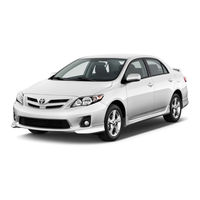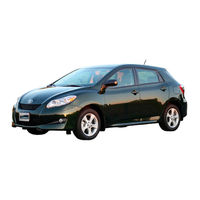Toyota 2012 corolla Manuals
Manuals and User Guides for Toyota 2012 corolla. We have 2 Toyota 2012 corolla manuals available for free PDF download: Manual, Quick Reference Manual
Toyota 2012 corolla Manual (507 pages)
Brand: Toyota
|
Category: Automobile
|
Size: 27 MB
Table of Contents
-
Keys10
-
Panic Mode25
-
Doors29
-
Front Seats39
-
Manual Seat40
-
Rear Seats42
-
Seat Belts46
-
When Driving58
-
Lock Switch59
-
Moon Roof61
-
Fuel Type66
-
SRS Airbags74
-
Unoccupied88
-
Booster Seat92
-
Multi-Mode Type127
-
Ai-Shift131
-
Parking Brake134
-
Horn135
-
Center Panel140
-
Indicators141
-
Warning Lights142
-
Driving Range144
-
Elapsed Time145
-
Headlight Switch147
-
Fog Light Switch151
-
Cruise Control156
-
Turning off TRAC161
-
Seating Capacity167
-
Trailer Towing172
-
Tongue Weight175
-
Weight Limits175
-
Hitch178
-
Before Towing182
-
Maintenance183
-
About Bluetooth207
-
Using the Radio217
-
-
Compatible Media234
-
File Names235
-
ID3 and WMA Tags235
-
Multi-Sessions235
-
Extensions236
-
Playback236
-
-
Control Panel238
-
Play Mode List239
-
Selecting a List240
-
Selecting Songs240
-
Shuffle Playback241
-
About Ipod242
-
Ipod Functions242
-
-
-
Selecting Files248
-
Scanning Files249
-
USB Memory250
-
Audio Unit267
-
Microphone268
-
Speed Dialing276
-
Inputting Digits278
-
Setting Ringtone291
-
Interior Light294
-
Glove Box297
-
Console Box297
-
Cup Holders299
-
Auxiliary Boxes302
-
Bottle Holders304
-
Sun Visors305
-
-
-
Vanity Mirrors306
-
Clock307
-
Ashtray308
-
Power Outlet310
-
Seat Heaters311
-
Floor Mat313
-
Compass314
-
Aluminum Wheels318
-
-
-
Bumpers319
-
Vehicle Interior326
-
Vehicle Exterior327
-
Hood333
-
Engine Oil340
-
Engine Coolant344
-
Brake Fluid345
-
Adding Fluid346
-
Battery Exterior348
-
Battery348
-
Washer Fluid350
-
Checking Tires352
-
Tire Rotation352
-
Tire Life355
-
Tire Types356
-
Wheel Selection364
-
Removal Method367
-
Key Battery369
-
Light Bulbs383
-
Front Fog Lights386
-
Back-Up Light391
-
Emergency Towing397
-
Visible Symptoms401
-
Audible Symptoms401
-
-
Vehicle424
-
Specifications446
-
Maintenance Data446
-
Engine Number448
-
Fuel450
-
Cooling System453
-
Ignition System453
-
Fuel Information458
-
Gasoline Quality458
-
Full-Size Tire461
-
Tire Size464
-
Tire Dimensions464
-
Treadwear466
-
What to Do If...503
-
Warning Lights505
Advertisement
Toyota 2012 corolla Quick Reference Manual (29 pages)
Brand: Toyota
|
Category: Automobile
|
Size: 2 MB
Table of Contents
-
Cup Holders20
-
Seat Belts23

